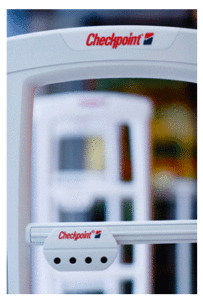Having a Checkpoint Systems Electronic Article Surveillance System (EAS) is only half a plan. Picture this: you buy a Checkpoint System (or heaven  forbid a competitive system). It is installed and your shoplifting losses go down. They will! The simple act of installing a system will make a percentage of your shoplifters go elsewhere.
forbid a competitive system). It is installed and your shoplifting losses go down. They will! The simple act of installing a system will make a percentage of your shoplifters go elsewhere.
But 6 months later you are scratching your head wondering why after the time, money, payroll dollars and effort you and your staff have put in, your shoplifting problem is climbing back up again. Your losses are more than you can take. Why?
Because…… you and your staff are not trained and do not have sufficient policies and procedures in place. I know what you are thinking now…. We are a small operation we don’t need that. Yep, you sure do! This part of the plan is not just for the big box stores. In fact you need it more than they do. You do not have a dedicated LP staff.
So if you are contemplating buying or have bought your Checkpoint System or other EAS system from somebody other than Loss Prevention Systems, you are missing out!
Loss Prevention System provides training! Not just how to use your Checkpoint System. We teach you how to prevent shoplifting with our FREE, PERSONALIZED (for you), LIVE TRAINING.
Our customers who purchase Checkpoint Systems from Loss Prevention Systems get free LP training for the LIFE of their Checkpoint System. Just buy your system, labels and tags from us. Is your EAS vendor doing that for you?
And that’s not all. We provide you more than shoplifting prevention training. How about employee theft and pre-employment interviewing training? All free, personalized and live. Taught by me, Bill Bregar, a 30+ year Loss Prevention Expert. Here are the courses:

But there is still more! This is NOT a onetime deal. We will tea ch these live webinars as reasonably often as you need. Staff turnover, promotions, follow up training, one employee or fifty…. Just schedule the session. Oh, by the way. I will also provide you with 15 draft LP Policies and Procedures that you can customize to your operation. Shoplifting, employee theft, robbery, key control…..
ch these live webinars as reasonably often as you need. Staff turnover, promotions, follow up training, one employee or fifty…. Just schedule the session. Oh, by the way. I will also provide you with 15 draft LP Policies and Procedures that you can customize to your operation. Shoplifting, employee theft, robbery, key control…..
As the founder of Loss Prevention Systems, I know that this training works. I have been training retail management and staff in loss prevention for over 30 years. Your losses will go down and it will help you to keep the losses in check.
Why am I doing this? Because I know that if I save you money, then you will be my customer. It’s that simple!
Loss Prevention Systems is so much more than someone selling you “stuff”. We want you to succeed!
So contact us today and let’s get you on the path to better margins!


 You know, we talk about the thousands of ways you, the small business owner, loses money to thieves constantly. Most of that is centered on shoplifters and boosters stealing your merchandise. We talk about that for good reason… it’s one of the biggest financial impacts to your business if left unchecked. However, there are so many other ways that your business can be targeted by criminals and some of them may appear so legitimate, that you would have no idea you were a victim for weeks. In that time, the criminal is long gone and you’re left paying for that theft out of your pocket. One area of training that is often overlooked in retail is check fraud. I’ll give you some advice on how to identify this in your store and protect yourself from vulnerability.
You know, we talk about the thousands of ways you, the small business owner, loses money to thieves constantly. Most of that is centered on shoplifters and boosters stealing your merchandise. We talk about that for good reason… it’s one of the biggest financial impacts to your business if left unchecked. However, there are so many other ways that your business can be targeted by criminals and some of them may appear so legitimate, that you would have no idea you were a victim for weeks. In that time, the criminal is long gone and you’re left paying for that theft out of your pocket. One area of training that is often overlooked in retail is check fraud. I’ll give you some advice on how to identify this in your store and protect yourself from vulnerability.

 According to the
According to the  It was 4:30am on a Tuesday morning. My company cell phone pierced through the quiet halls of my house. At first, I didn’t get out of bed; perhaps it was a wrong number. Silence. As I doze back off, I hear the familiar tone once again. Who could be calling me and for what reason at this hour? I let it ring. I hear the chirp of the voicemail. Before I can muster the energy to get out of bed, I hear my personal phone ringing. This one is next to me on the night stand. Something is wrong, I immediately think to myself. When I reach for my phone in the middle of the dark room, eyes still blurry, I see the caller ID. It’s a sheriff’s deputy that I’m good friends with. My heart is in my throat as I answer. “You’re morning crew was just robbed at gunpoint. Get to the store now.”
It was 4:30am on a Tuesday morning. My company cell phone pierced through the quiet halls of my house. At first, I didn’t get out of bed; perhaps it was a wrong number. Silence. As I doze back off, I hear the familiar tone once again. Who could be calling me and for what reason at this hour? I let it ring. I hear the chirp of the voicemail. Before I can muster the energy to get out of bed, I hear my personal phone ringing. This one is next to me on the night stand. Something is wrong, I immediately think to myself. When I reach for my phone in the middle of the dark room, eyes still blurry, I see the caller ID. It’s a sheriff’s deputy that I’m good friends with. My heart is in my throat as I answer. “You’re morning crew was just robbed at gunpoint. Get to the store now.”

